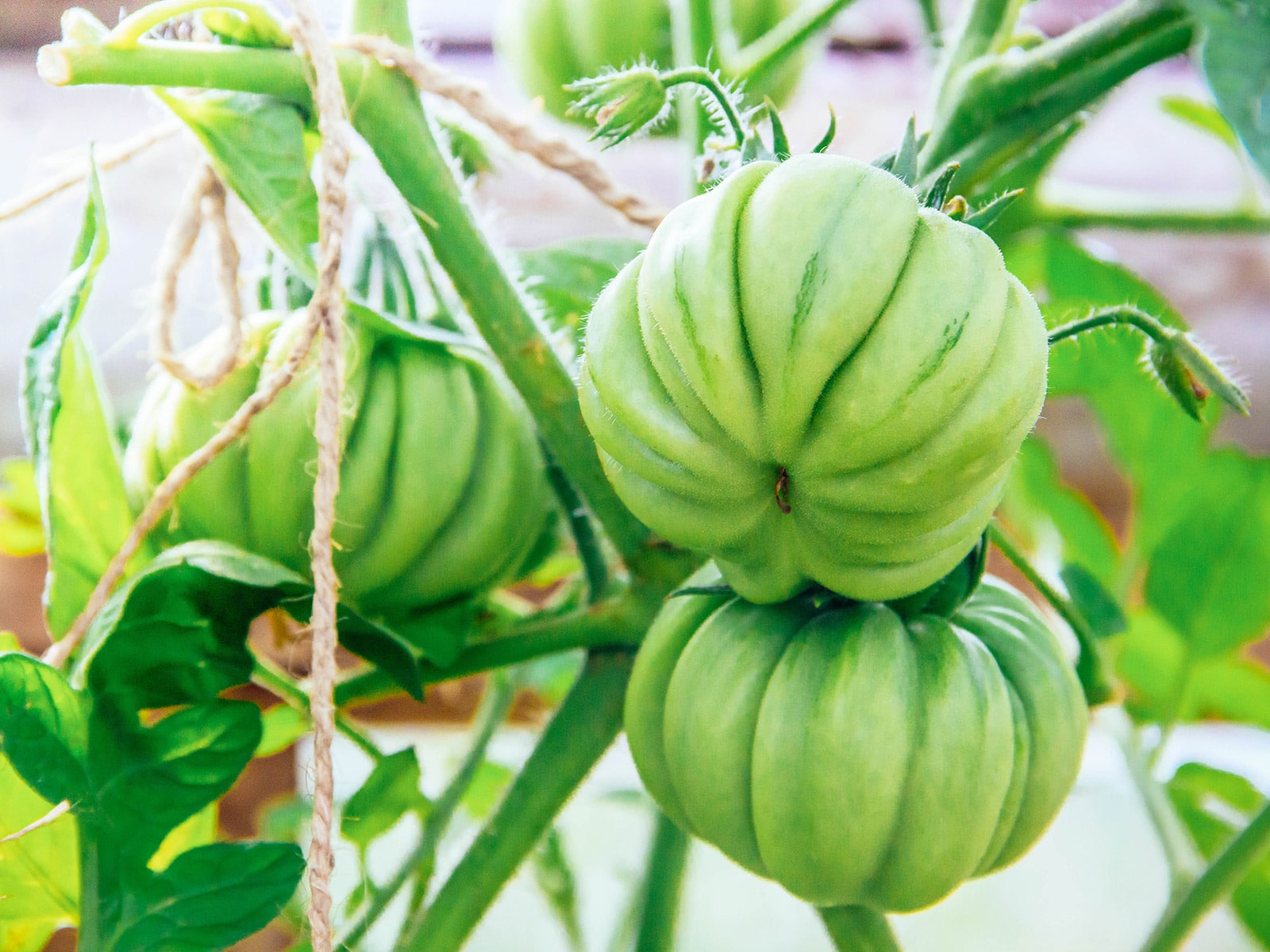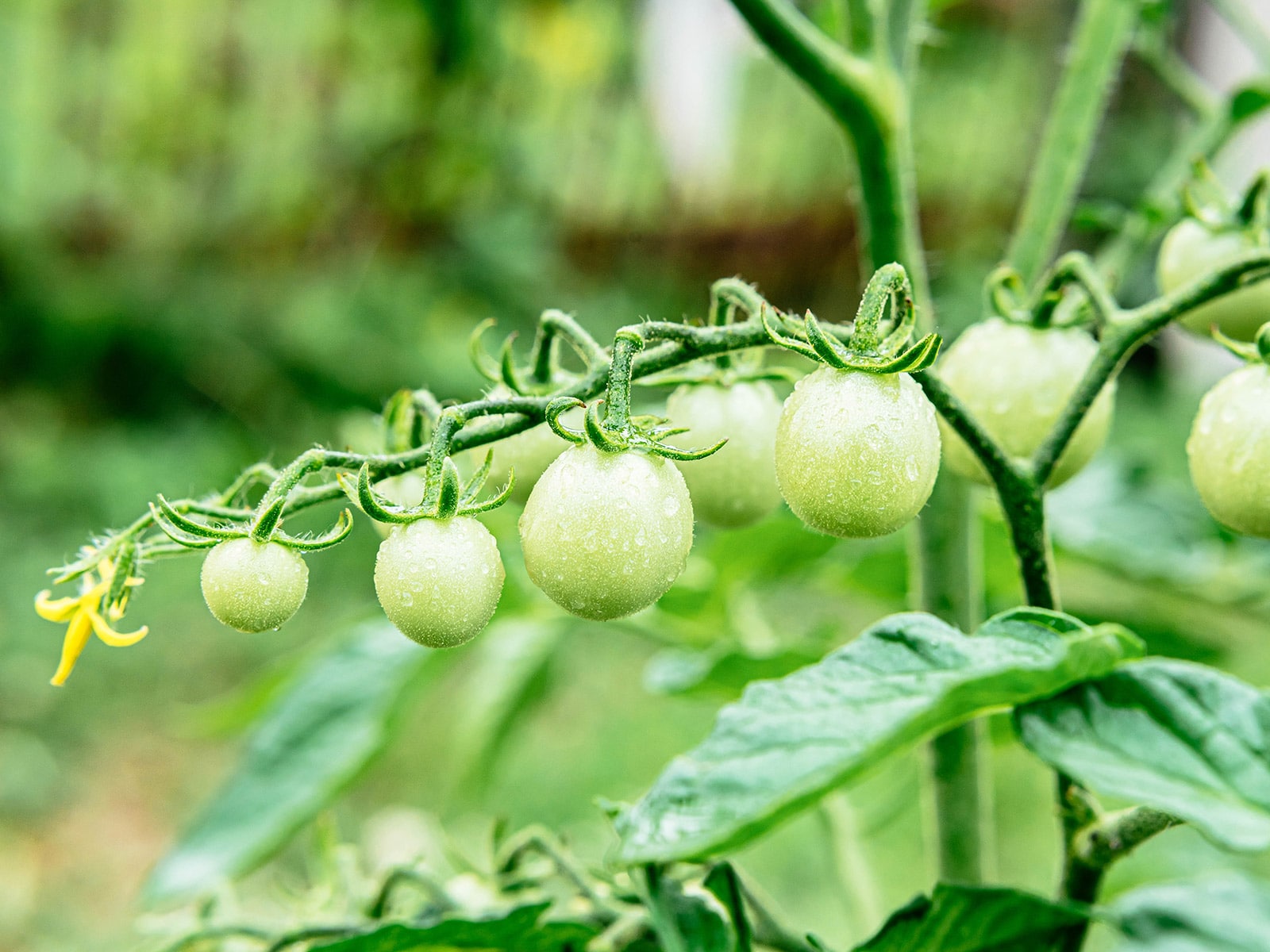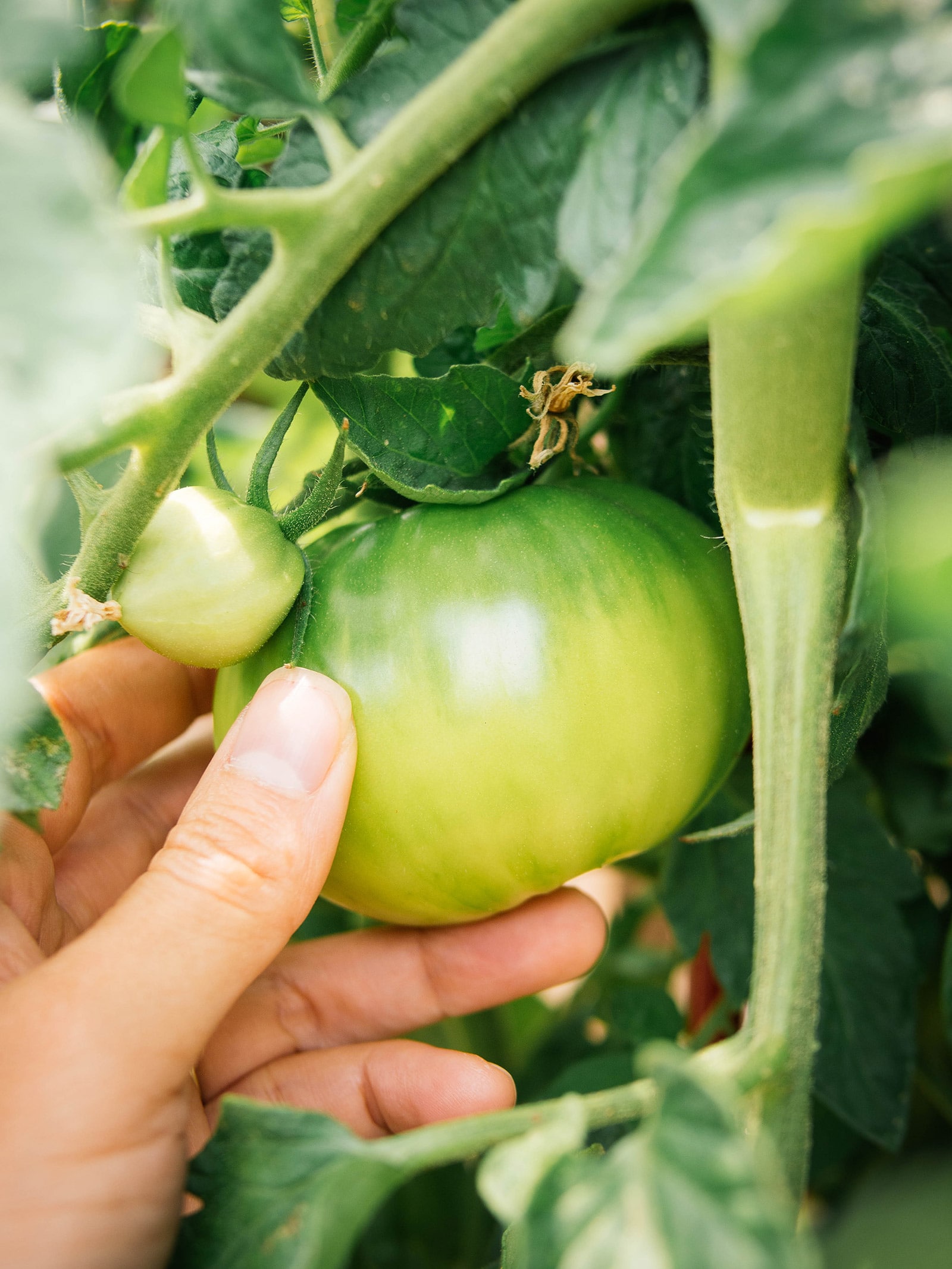Ever since I started gardening, tomatoes have been my passion crop. Every spring I start at least a dozen varieties from seed, some that I’ve purchased and some that I’ve fermented and saved.
I love the rainbow of colors (from creamy white to deep indigo), the incredible flavor of heirloom tomatoes, and the intoxicating smell of tomato leaves which coat my hands after rifling through the vines in search of perfectly ripe fruit.
But this time of year, the very thing that brings me joy—harvesting baskets of tomatoes—can be a source of frustration, especially in Central Oregon where the season is short and my tomatoes are annoyingly slow to ripen.
No matter how early they may have been started indoors or inside greenhouses, there always seem to be a few holdouts every year that stubbornly stay green as the weather begins to turn dangerously close to freezing.
Related: How to look up your first frost date
That’s because as a tropical perennial in its native Peruvian highlands, land of eternal summer, the tomato plant doesn’t have the same biochemical triggers other plants have that forces it to wind down and produce seed quickly as temperatures start to dip.
This means your tomato plants will continuously put out more foliage and fruit until they’re cut down or killed by frost, and as the days get shorter, your plants are likely to slow down.
But, you don’t have to relegate yourself to yet another homemade batch of pickled green tomatoes this year… at least, not right away.
Make this: The best roasted green tomato salsa verde recipe
Try a few of these simple tricks to hasten ripening as the days shorten and the weather cools!

How to ripen tomatoes in the garden—fast
Trick #1: Pinch off the top of the plant.
If you’re only a few weeks away from the first frost and still see a fair amount of green tomatoes on the vine, the best way to promote faster ripening is to pinch off (cut) the top of your tomato plant.
Just remove the tip of the main stem above the topmost blossom. This prevents the plant from growing any taller and producing more flowers. It’s the final pruning you have to do for your tomato plant.
I also like to remove any green fruits that haven’t yet reached their mature size. Without its resources being wasted on growing immature fruit to full size, the plant can channel its energy into ripening the fruit it’s already produced.
Some studies have shown that reducing the number of fruit not only speeds up ripening, but also improves the size, flavor, and nutrient content of the harvest. So it’s a win-win!

Trick #2: Induce stress.
One easy way to encourage tomatoes to ripen faster is to induce stress.
If tomato plants sense that their survival is at stake, they’ll speed up the maturation of their fruits to produce seed and create the next generation of plants.
You can induce stress simply by reducing the amount of water you give them.
Do this gradually to allow the plants to adapt, giving less and less water each time over a three-week period. You don’t want to stress the plants too much at first (which could cause blossom end rot or split or cracked tomatoes).
This intentional withholding of water is similar to a growing technique known as dry farming, which commercial farmers use to improve flavor.
The fruits end up smaller than tomatoes left to ripen on the vine under normal conditions, but restricting the plant’s water intake increases the fruits’ sugar content and other flavor compounds, resulting in sweeter and richer tomatoes.
So, this trick could give you a tasty bonus in addition to helping your fruits ripen sooner!
(I should add, however, that simply not watering your plants is not an ideal way to grow tomatoes. A successful crop of dry-farmed tomatoes has to be dry-farmed from the beginning under specific climate and soil conditions.)

Trick #3: Try root pruning.
Another easy way to induce stress is via root pruning, which interrupts the plant’s growth cycle. This special technique hampers the plant’s absorption of water and sends out distress signals, telling it to hurry up and ripen the tomatoes it’s produced.
To do this, simply insert a spade 6 to 8 inches deep into the soil, about 1 foot away from the main stem, and circle the plant while continuously digging in the spade. This will cut the outermost roots, putting the plant into survival mode and forcing it to mature more than it would otherwise.
Generally, the best time to root prune a tomato plant is after several clusters of fruits have developed, but just before they begin to ripen.
I usually do this three to four weeks before the first frost in my area, though timing may differ for your garden and climate.
Combine root pruning with reduced watering (as mentioned in trick #2 above), and your “laziness” at the end of the season will reward you with better-tasting, more nutritious fruit and less waste in the garden!
Read more: Save time with my efficient gardening strategies that maximize production

Trick #4: Ripen tomatoes indoors with a bit of apple peel.
If a sudden early frost has you bringing in all your unripe tomatoes indoors, you can speed up ripening by placing your tomatoes in brown paper bags (loosely and in single or double layers, not piled heavily on top of each other) with a bit of fresh apple peel inside.
Apples emit high amounts of ethylene, a colorless, odorless, naturally occurring gas that causes the flesh to soften and the sugar content to rise (a process we know as ripening).
With the aid of ethylene, your green tomatoes should ripen within a week, versus the two weeks it would normally take mature green fruit to reach ripeness.
And that’s key to ripening tomatoes properly indoors: always pick mature green fruits.
These are the ones that have grown to full size and may already have a slight tinge of yellow on the outside. If you cut into a sacrificial piece of green fruit, you should see a gelatinous texture and some type of color shift on the inside.
Mature green tomatoes have the best chance of ripening off the vine indoors, and in fact, this is the best time to pick tomatoes because they’re less likely to succumb to the effects of pests, frost, heavy rains, or heat waves.
Sort and separate yours according to stage of ripeness (from mostly green to halfway ripe), as it’ll help you discern when each batch is ripe and ready by checking only a few test fruits (instead of needing to open and check the whole bag).
Keep the unripe fruits in a cool, dry spot in the house at temperatures between 68°F and 75°F for best results—never refrigerate them, which not only halts the ripening process, but can turn the flesh mealy after prolonged cold exposure.
How long does it take for tomatoes to ripen on the vine?
When you plant tomatoes, you’re in it for the long haul.
In fact, most people are surprised to learn that the “days to maturity” label on their seed packets (say, 65 days or 90 days) is typically the amount of time after transplanting that it takes to harvest the first ripe tomatoes!
So you can easily add three to six weeks to that (very rough) timetable.
Can’t wait that long? If you have a short growing season, don’t fret: here are my favorite short-season tomato varieties that don’t mind cooler weather.
In general, I’ve found that once a tomato flower appears, it’ll produce mature green fruit in two to three weeks. It then takes another two to three weeks for the fruit to fully ripen—so you’re looking at four to six weeks from flower to harvest.
And this is on the quicker end of things.
Smaller cherry tomatoes usually take four to six weeks to go from flower to harvest, while larger slicing tomatoes may take up to eight weeks to ripen (under optimal conditions).
This post updated from an article that originally appeared on August 10, 2021.
















You didn’t mention spraying tomato leaves with aspirin solution. One 325mg aspirin tablet (uncoated), crushed & dissolved in 1 gallon of water (some gardeners also add a teaspoon of dish soap), sprayed on the leaves early in the morning, every two weeks will turbo-charge your tomato plants. Salicylic acid mimics the hormone that tomatoes release when they are under attack & it will increase your tomato plant growth rate dramatically. Repeat every two weeks.
I couldn’t plant my tomatoes this year as we we’re putting up a fence. Thank you for the advice I will try a combination of these techniques in order to enjoy the massive fruits that are taunting me on the vine right now. 😉
Hi Betty
I appreciate your articles, as older fella starting my garden journey again after many years away from it my first full season this year was amazing in many ways. First off 3 raised beds with about 50 watt all together and 2 strawberry beds with 24 sqft. I also attempted containers with some mixed results. My tomatoes, a cherry, a Big daddy cherry and a Roma have been outrageous. It is Sept 28th here in Colorado’s Front Range garden survived 2 hail incidents this year. The containers were somewhat experimental using grow bags and plastic. Still have fruiting peppers in containers and in one of beds. I did a variety of vegetables and learned alot about what works and what does not. My response about the tomaties, been bagging to speed ripening then freezing, been topping the tomatoes plants but going to do one last time as I know we are getting close to end of season. The cherry tom. grew way higher than my trellis, 6 ft above container level which are 30″ high to begin with. That’s all for now keep up your blogging, thanks
PS sorry I did not report on all my vegetables as some were abundant others not so much due to location in beds at times and over planting in the containers, though reduced peppers to one per font and then they took off. I had over a dozen vegetable an
Living in South Fl. ……Developed plants from a slice of tomatoes….
Tomatoe plant is about 6feet tall…blossoms no tomatoes…..
Too hot, I assume… it’s on my Juliet balcony …..after living in houses the past and now
In an apt. did like the process of having a minuteman garden….
With the holiday season approaching, we’re planning a trip with our dog. What tips can you share for preparing a pet for a long car ride? What should we bring along, and how can we minimize stress for our dog?
Thanks for the tips!!! I always like reading your blog!!
I didn’t know this and I somehow managed to do most of these tricks XD I hope my tomato will taste good
Thank you!
These are great recommendations for ripening. I was getting concerned, as this is the first time I’ve planted so many tomatoes. Our 50/50 risk of frost is October 2nd. I have scads of green cherry tomatoes and a good number of green heirloom Brandywine too.